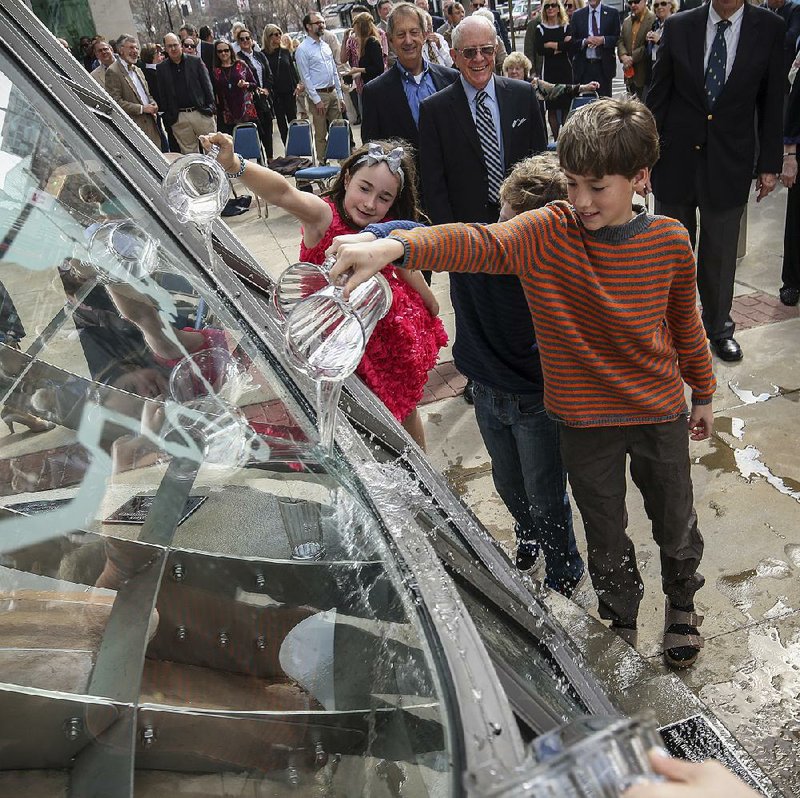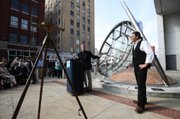A sculpture commemorating the bicentennial of the Louisiana Purchase survey was about a dozen years in the making, but it can't compare to the difficulties faced by two unsung government surveyors 200 years ago, sculptor Michael Warrick said Monday.
The sculpture, placed in front of the Statehouse Convention Center in Little Rock, is a tribute to government surveyors Prospect Robbins and Joseph Brown, as well as to Arkansas' role in the creation of the "initial point" for the "first survey of the American West."
A National Historic Landmark at the junction of Lee, Monroe and Phillips counties near Brinkley marks the initial point, or the first surveyor mark, for initiating all surveys of the entire Louisiana Purchase territory.
Warrick, a University of Arkansas at Little Rock art professor, and Aaron Hussey, a UALR alumnus who was a student of Warrick's, relied on a "persistence and a real sense of adventure to make it [the sculpture] happen," Warrick said. They drew inspiration, he said, from the "commitment and perseverance" of Robbins and Brown in forging ahead to complete the artwork commissioned by the Committee for Louisiana Purchase Survey Bicentennial Monument. Their vision was chosen from a national competition.
"Just think of what those two surveyors went through," Warrick said after Monday's dedication of the sculpture made of tempered glass, stainless steel, cast bronze and concrete. "Part of recognizing the importance of that event is not just the purchase, but the survey that followed."
Hussey, of Baton Rouge, said he "personally wrote this off at least five times," before the project could be finalized and the artwork emerged to represent surveyor's tools.
The 18-foot-high, 12-foot-wide, 13-foot-deep sculpture is of a compass face of tempered glass with an etching of the Louisiana Purchase territory and an Arkansas outline within it. Behind the compass lies a dome with patterns representing latitude and longitude lines with the base representing the Earth. A 5-foot-long cast bronze plumb bob -- an instrument used as a vertical reference line -- and a brass leg that represents a survey tripod supports the sculpture's compass.
President James Madison commissioned Robbins and Brown to conduct the first survey of the lands west of the Mississippi River. The survey began Oct. 27, 1815, with Robbins walking north from the confluence of the Arkansas and Mississippi rivers, while Brown walked west from the junction of the St. Francis and Mississippi rivers. Where the two surveyors' lines crossed established the initial point.
The committee raised $190,000 to pay for the sculpture. Survey Committee Chairman John Gill officially transferred ownership to Little Rock on Monday.
"This project grew out of the bicentennial celebration of the Louisiana Purchase, which was in 2003," Gill said. "That was the 200th year. There were a lot of stumbling blocks along the way. Raising money was one."
The sculpture's title, Straight Lines on a Round World, is a nod to the surveyors' work, Gill said. The sculpture also is a tribute to Robbins and Brown, whom Gill described as "two unsung American heroes."
City Director Dean Kumpuris aided in securing the sculpture's location outside of the Statehouse Convention Center along Markham Street downtown, Warrick said.
Kumpuris, a promoter of public art in the city, called the sculpture "a wonderful piece to be added to the city."
"Art helps a city," Kumpuris said. "Art makes us all better and certainly makes the community better."
Metro on 02/21/2017

